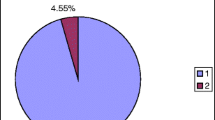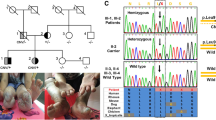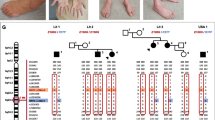Abstract
The hereditary sensory and autonomic neuropathies (HSAN, also known as the hereditary sensory neuropathies) are a clinically and genetically heterogeneous group of disorders, characterised by a progressive sensory neuropathy often complicated by ulcers and amputations, with variable motor and autonomic involvement. To date, mutations in twelve genes have been identified as causing HSAN. To study the frequency of mutations in these genes and the associated phenotypes, we screened 140 index patients in our inherited neuropathy cohort with a clinical diagnosis of HSAN for mutations in the coding regions of SPTLC1, RAB7, WNK1/HSN2, FAM134B, NTRK1 (TRKA) and NGFB. We identified 25 index patients with mutations in six genes associated with HSAN (SPTLC1, RAB7, WNK1/HSN2, FAM134B, NTRK1 and NGFB); 20 of which appear to be pathogenic giving an overall mutation frequency of 14.3%. Mutations in the known genes for HSAN are rare suggesting that further HSAN genes are yet to be identified. The p.Cys133Trp mutation in SPTLC1 is the most common cause of HSAN in the UK population and should be screened first in all patients with sporadic or autosomal dominant HSAN.


Similar content being viewed by others
References
Carvalho OP, Thornton GK, Hertecant J, Houlden H, Nicholas AK, Cox JC, Reilly MM, Al-Gazali L, Woods CG (2011) A novel NGF mutation clarifies the molecular mechanism and extends the phenotypic spectrum of the HSAN5 neuropathy. J Med Genet 48:131–135
Dyck PJ (1993) Neuronal atrophy and degeneration predominantly affecting peripheral sensory and autonomic neurons. In: Dyck PJ, Thomas PK, Griffin JW, Low PA, Poduslo JF (eds) Peripheral neuropathy. W.B Saunders, Philadelphia, pp 1065–1093
Eichler FS, Hornemann T, McCampbell A, Kuljis D, Penno A, Vardeh D, Tamrazian E, Garofalo K, Lee H-J, Kini L, Selig M, Frosch M, Gable K, von Eckardstein A, Woolf CJ, Guan G, Harmon JM, Dunn TM, Brown RH Jr (2009) Overexpression of the wild-type SPT1 subunit lowers deoxysphingolipid levels and rescues the phenotype of HSAN1. J Neurosci 29:14646–14651
Einarsdottir E, Carlsson A, Minde J, Toolanen G, Svensson O, Solders G, Holmgren G, Holmberg D, Holmberg M (2004) A mutation in the nerve growth factor beta gene (NGFB) causes loss of pain perception. Hum Mol Genet 13:799–805
Fitzgibbon GJ, Kingston H, Needham M, Gaunt L (2009) Haploinsufficiency of the nerve growth factor beta gene in a 1p13 deleted female child with an insensitivity to pain. Dev Med Child Neurol 51:833–837
Guelly C, Zhu P-P, Leonardis L, Papic L, Zidar J, Schabhuttl M, Strohmaier H, Weis J, Strom TM, Baets J, Willems J, de Jonghe P, Reilly MM, Frohlich E, Hatz M, Trajanoski S, Pieber TR, Janecke AR, Blackstone C, Auer-Grumbach M (2011) Targeted high-throughput sequencing identifies mutations in atlastin-1 as a cause of hereditary sensory neuropathy type I. Am J Hum Genet 88:99–105
Hornemann T, Penno A, Richard S, Nicholson G, van Dijk FS, Rotthier A, Timmerman V, von Eckardstein A (2009) A systematic comparison of all mutations in hereditary sensory neuropathy type I (HSAN I) reveals that the G387A mutation is not disease associated. Neurogenetics 10:135–143
Houlden H, Blake J, Reilly MM (2004) Hereditary sensory neuropathies. Curr Opin Neurol 17:569–577
Houlden H, King R, Blake J, Groves M, Love S, Woodward C, Hammans S, Nicoll J, Lennox G, O’Donovan DG, Gabriel C, Thomas PK, Reilly MM (2006) Clinical, pathological and genetic characterization of hereditary sensory and autonomic neuropathy type 1 (HSAN I). Brain 129:411–425
Houlden H, King RH, Muddle JR, Warner TT, Reilly MM, Orrell RW, Ginsberg L (2004) A novel RAB7 mutation associated with ulcero-mutilating neuropathy. Ann Neurol 56:586–590
Indo Y (2001) Molecular basis of congenital insensitivity to pain with anhidrosis (CIPA): mutations and polymorphisms in TRKA (NTRK1) gene encoding the receptor tyrosine kinase for nerve growth factor. Hum Mutat 18:462–471
Klein CJ, Botuyan MV, Wu Y, Ward CJ, Nicholson GA, Hammans S, Hojo K, Yamanishi H, Karpf AR, Wallace DC, Simon M, Lander C, Boardman LA, Cunningham JM, Smith GE, Litchy WJ, Boes B, Atkinson EJ, Middha S, Dyck PJB, Parisi JE, Mer G, Smith DI, Dyck PJ (2011) Mutations in DNMT1 cause hereditary sensory neuropathy with dementia and hearing loss. Nat Genet 43:95–600
Kurth I, Pamminger T, Hennings JC, Soehendra D, Huebner AK, Rotthier A, Baets J, Senderek J, Topaloglu H, Farrell SA, Nurnberg G, Nurnberg P, De Jonghe P, Gal A, Kaether C, Timmerman V, Hubner CA (2009) Mutations in FAM134B, encoding a newly identified Golgi protein, cause severe sensory and autonomic neuropathy. Nat Genet 41:1179–1181
Lafreniere RG, MacDonald ML, Dube MP, MacFarlane J, O’Driscoll M, Brais B, Meilleur S, Brinkman RR, Dadivas O, Pape T, Platon C, Radomski C, Risler J, Thompson J, Guerra-Escobio AM, Davar G, Breakefield XO, Pimstone SN, Green R, Pryse-Phillips W, Goldberg YP, Younghusband HB, Hayden MR, Sherrington R, Rouleau GA, Samuels ME (2004) Identification of a novel gene (HSN2) causing hereditary sensory and autonomic neuropathy type II through the Study of Canadian Genetic Isolates. Am J Hum Genet 74:1064–1073
Minde J, Anderson T, Fulford M, Aguirre M, Nennesmo I, Remahl IN, Svensson O, Holmberg M, Toolanen G, Solders G (2009) A novel NGFB point mutation: a phenotype study of heterozygous patients. J Neurol Neurosurg Psychiatry 80:188–195
Minde J, Toolanen G, Andersson T, Nennesmo I, Remahl IN, Svensson O, Solders G (2004) Familial insensitivity to pain (HSAN V) and a mutation in the NGFB gene. A neurophysiological and pathological study. Muscle Nerve 30:752–760
Miura Y, Mardy S, Awaya Y, Nihei K, Endo F, Matsuda I, Indo Y (2000) Mutation and polymorphism analysis of the TRKA (NTRK1) gene encoding a high-affinity receptor for nerve growth factor in congenital insensitivity to pain with anhidrosis (CIPA) families. Hum Genet 106:116–124
Murphy SM, Davidson GL, Brandner S, Houlden H, Reilly MM (2012) Mutation in FAM134B causing severe hereditary sensory neuropathy. J Neurol Neurosurg Psychiatry 83:119–120
Penno A, Reilly MM, Houlden H, Laura M, Rentsch K, Niederkofler V, Stoeckli E, Nicholson G, Eichler F, Brown RH Jr, von Eckardstein A, Hornemann T (2010) Hereditary sensory neuropathy type 1 is caused by the accumulation of two neurotoxic sphingolipids. J Biol Chem 285:11178–11187
Rafel E, Alberca R, Bautista J, Navarrete M, Lazo J (1980) Congenital insensitivity to pain with anhidrosis. Muscle Nerve 3:216–220
Reilly MM, Shy ME (2009) Diagnosis and new treatments in genetic neuropathies. J Neurol Neurosurg Psychiatry 80:1304–1314
Riviere JB, Ramalingam S, Lavastre V, Shekarabi M, Holbert S, Lafontaine J, Srour M, Merner N, Rochefort D, Hince P, Gaudet R, Mes-Masson AM, Baets J, Houlden H, Brais B, Nicholson GA, Van Esch H, Nafissi S, De Jonghe P, Reilly MM, Timmerman V, Dion PA, Rouleau GA (2011) KIF1A, an axonal transporter of synaptic vesicles, is mutated in hereditary sensory and autonomic neuropathy type 2. Am J Hum Genet 89:219–230
Rotthier A, Auer-Grumbach M, Janssens K, Baets J, Penno A, Almeida-Souza L, Van Hoof K, Jacobs A, De Vriendt E, Sclotter-Weigel B, Loscher WN, Vondracek P, Seeman P, De Jonghe P, Van Dijck P, Jordanova A, Hornemann T, Timmerman V (2010) Mutations in the SPTLC2 subunit of serine palmitoyltransferase cause hereditary sensory and autonomic neuropathy type I. Am J Hum Genet 87:513–522
Rotthier A, Baets J, De Vriendt E, Jacobs A, Auer-Grumbach M, Levy N, Bonello-Palot N, Kilic SS, Weis J, Nascimento A, Swinkels M, Kruyt MC, Jordanova A, De Jonghe P, Timmerman V (2009) Genes for hereditary sensory and autonomic neuropathies: a genotype-phenotype correlation. Brain 132:2699–2711
Acknowledgments
We are grateful to the patients and families who support our research. We would like to thanks the following for essential grant support; The Medical Research Council (MRC) MMR and HH (MRC fellowship, G108/638 and G0802760), The Brain Research Trust (BRT) (HH), Ataxia UK (HH), The BMA Vera Down Award (HH) and the Muscular Dystrophy Campaign UK and association USA (HH and MMR). SMM and MMR are grateful to the NINDS/ORD (1U54NS065712-01) for their support. MAS was supported by the College of Medicine Research Center (CMRC, Project No. 05-495), College of Medicine, King Saud University, Riyadh, Saudi Arabia. This work was undertaken at University College London Hospitals/University College London, which received a proportion of funding from the Department of Health’s National Institute for Health Research Biomedical Research Centres funding scheme. This study was funded by a UCLH/UCL Comprehensive Biomedical Research Centre (CBRC) Grant. We would like to thank the following for essential grant support; The Medical Research Council (MRC) MMR and HH (MRC fellowship, G108/638 and G0802760), The Brain Research Trust (BRT) (HH), Ataxia UK (HH), The BMA Vera Down Award (HH) and the Muscular Dystrophy Campaign UK and association USA (HH and MMR). SMM and MMR are grateful to the NINDS/ORD (1U54NS065712-01) for their support. MAS was supported by the College of Medicine Research Center (CMRC, Project No. 05-495), College of Medicine, King Saud University, Riyadh, Saudi Arabia. FM is supported by the Great Ormond Street Hospital Children’s charity. This work was undertaken at University College London Hospitals/University College London, which received a proportion of funding from the Department of Health’s National Institute for Health Research Biomedical Research Centres funding scheme.
Conflicts of interest
GL Davidson, JM Polke, M Laura, MAM Salih, J Blake, S Brandner, N Davies, R Horvath, S Price, M Donaghy, M Roberts, N Foulds, G Ramdharry, D Soler, MP Lunn, H Manji, MB Davis have no disclosures. SM Murphy is the recipient of a Post Doctoral training fellowship from the Inherited Neuropathy Consortium Rare Disease Clinical Research Consortium supported by the NINDS/ORD (1U54NS065712-01). F Muntoni serves on a scientific advisory board for AVI BioPharma, Inc.; serves on the editorial boards of Neuromuscular Disorders and Neuropaediatrics; is listed as an author on a pending patent re: Tailed antisense nucleotides to redirect splicing; receives publishing royalties for Duchenne Muscular Dystrophy (Oxford University Press, 2003); and receives research support from AVI BioPharma, Inc., PTC Therapeutics, Inc., GlaxoSmithKline, Wellcome Trust, the European Union, Medical Research Council UK, Muscular Dystrophy Campaign, Muscular Dystrophy Association USA, Spinal Muscular Atrophy Foundation, the NIH, the Association Francaise contre les myopathies (AFM), the NIHR, and the Great Ormond Street Hospital Children’s Charity. H Houlden receives research support from The Medical Research Council (MRC fellowship, G108/638 and G0802760), The Brain Research Trust, Ataxia UK, The BMA Vera Down Award and the Muscular Dystrophy Campaign UK and association USA. MM Reilly receives research support from The Medical Research Council, the Muscular Dystrophy Campaign and NINDS/ORD (1U54NS065712-01). This work was undertaken at University College London Hospitals/University College London, which received a proportion of funding from the Department of Health’s National Institute for Health Research Biomedical Research Centres funding scheme.
Author information
Authors and Affiliations
Corresponding author
Additional information
G. L. Davidson and S. M. Murphy contributed equally to the manuscript.
Electronic supplementary material
Below is the link to the electronic supplementary material.
Rights and permissions
About this article
Cite this article
Davidson, G.L., Murphy, S.M., Polke, J.M. et al. Frequency of mutations in the genes associated with hereditary sensory and autonomic neuropathy in a UK cohort. J Neurol 259, 1673–1685 (2012). https://doi.org/10.1007/s00415-011-6397-y
Received:
Revised:
Accepted:
Published:
Issue Date:
DOI: https://doi.org/10.1007/s00415-011-6397-y




